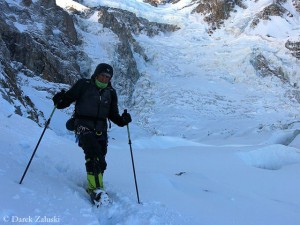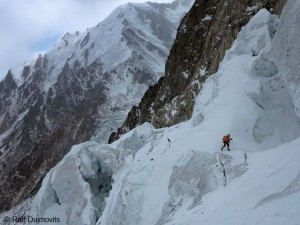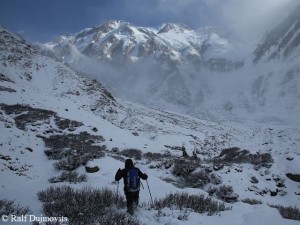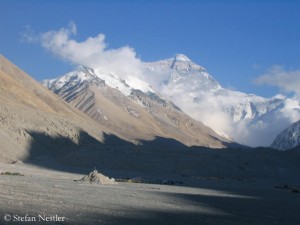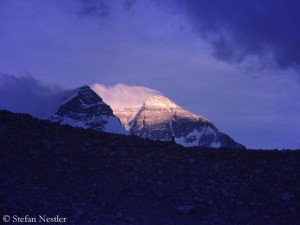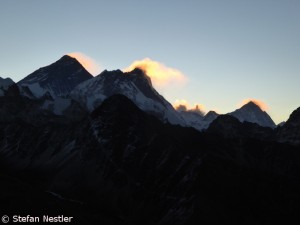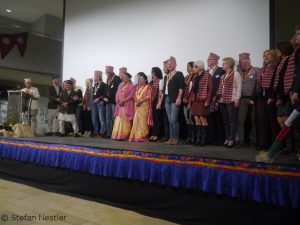Dujmovits returns to Mount Everest
Two weeks have passed since Ralf Dujmovits has decided to abandon his winter expedition on Nanga Parbat due to the strong risk of icefall. Two weeks to reflect on his experiences in Pakistan and also to look ahead. I call the 52-year-old German climber at home, in the town of Buehl at the foot of the Black Forest.
Ralf, what does German winter feel like, compared with winter in Pakistan, in particular on Nanga Parbat?
I stood at Frankfurt airport and then at the stations in Mannheim and Karlsruhe wearing a short-sleeved shirt, all around me people wrapped up in winter clothes. I had to get used again to the warm temperatures. We have a very warm winter in Germany, a real contrast to what we had in Pakistan. Whatever, I feel that I`m arriving also mentally and I am enjoying the warmth again.
Has your disappointment blown over that you had to give up your plan to climb the mountain for the first time in winter already at 5500 meters?
I am still disappointed. Of course I’m sad that it did not work. On the other hand, if I view the images and see where I have climbed I must say it was certainly the right decision. And that we had a narrow escape from a large ice avalanche on the last day was a sign for us to pack up and leave. Therefore, this sadness is within limits.
You talked about the ice avalanche that went down after you had broken down your high camp. How close was it?
The last chunks of ice were about 15 meters away, some of them were as big as a fridge. We were really very lucky. We were running as fast as it was possible in the deep snow.
Did you feel confirmed by this incident that it was the right decision to abandon the expedition?
Yes, indeed. I’m worried that the area where the ice avalanche started is threatening the normal way up to Camp 1 on the Kinshofer route. This makes me think for future expeditions. There must be a warning. Admittedly, during our expedition the icefall was really active. But whenever you want to climb to the summit via the normal route you have to pass underneath this icefall.
Your plan was to acclimatize elsewhere under easier conditions, to climb up and down quickly and depart. Have you paid dearly on Nanga Parbat?
The time slot to realize this plan is relatively short. Of course I knew that before. But I have learned the hard way that you are getting into trouble if the weather window doesn’t open as expected. You are asking yourself whether this will really work, whether you are really acclimatized well enough. Actually you should set a time slot of ten, maximum 14 days and stock up food only for this period. If it works, everything’s allright, if not, your are going home again. But of course in winter the weather must fit.
Or it takes a lot of patience – as you can see now on the other side of the mountain, where until now the teams have not climbed higher than 6000 meters.
Darek (Zaluski, Ralf’s companion on Nanga Parbat) told me that this was the normal process of winter expeditions: Climbers are working upwards slowly, fixing ropes, losing power more and more. That really takes it out of you. In this case, according to Darek, the chance to get beyond the key point of the route and to traverse to the Diamir side at 7400 meters is extremely low.
Before you started to Pakistan you told me that you wanted to give a signal that despite last summer’s terror attack at Diamir basecamp it was furthermore possible to go there on expedition. Can you still recommend it?
That’s a difficult question. On the one hand you have the problem with the Taliban in the far periphery of Nanga Parbat. But I think the greater problem results from the sociocultural situation right in the Diamir Valley above Chilas. The people living in this area are very conservative and fundamentalist. There are still many feuds. If someday grandfathers had a dispute, their grandchildren will carry it on. The people can barely be described as open to strangers. It’s not quite like feeling welcome. I am no longer one hundred percent sure that the assassination in the basecamp was really committed by the alleged Taliban. I am saying this quite frankly, I have strayed far from my original conviction.
What are you planning next?
This year I will be travelling a lot. At the end of February I will go to Tierra del Fuego to produce a TV documentary about the Indians living there. We (he, his wife Gerlinde Kaltenbrunner, Ralf Gantzhorn and Rainer Pircher) also want to climb Monte Sarmiento. After that I will stay two days at home before starting to Mount Everest .
In order to finally reach the summit without oxygen, in the fourth attempt?
It will definitely be my last attempt. I’ll try it again, this time on the north side .
As a member of an international expedition?
In the basecamp I ‘m probably with others, but on the mountain I want to act completely independently and to choose the route that fits best. I won’t put myself under any pressure. It would be great to climb up via the upper part of the Norton couloir, but I am keeping all options open. I am not worried about my fitness. I hope I will be successful this time. I’ll do my best.



